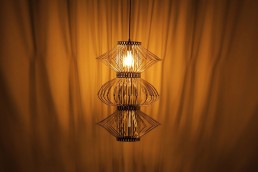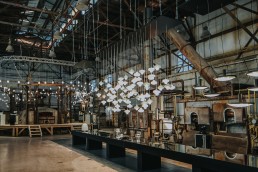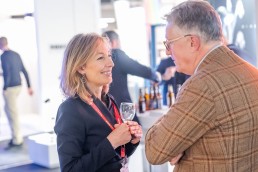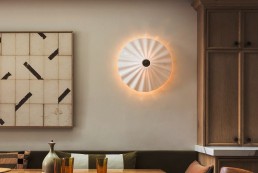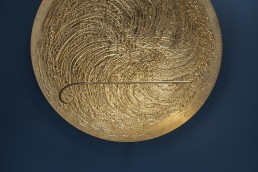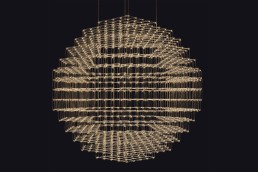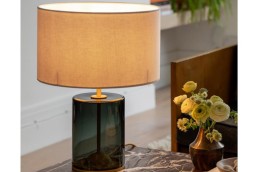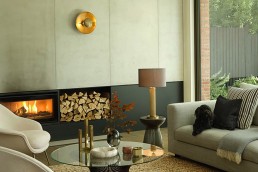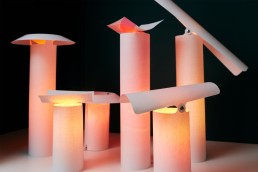Istituto Marangoni London announces graduate exhibition
(UK) – Fashion and design school Istituto Marangoni London hosts its inaugural graduate exhibition at the Design Museum during London Design Festival.
Titled ‘Momentum: A design Narrative’, the exhibition brings together 12 BA and MA graduates across the fields of jewellery, interior, and visual design, showcasing creative solutions for modern society and forging new narrative within the industry.
Taking place 13-14 September at the mezzanine level at the Design Museum, the exhibition presents an opportunity for selected graduates to exhibit their works in one of the world’s leading design institutions and work alongside the museum’s curator and programming teams.
In the lead up to submitting final projects, the students received support from the school’s cohort of academics and industry experts, including London-based design agency, Pearson Lloyd, who were appointed as mentors for the 2023/2024 academic year. Students were encouraged to develop creative and innovative solutions while being mindful of designing with a positive and lasting impact on our environment and communities.
MA Product Design student, Yinghua Zha, will be showcasing their Yinghua Zhan a self-assembled modular light product designed with a focus on sustainability. Yinghua envisioned a 3-D folding shape with a modular pattern that can turn into a half-rhombus and half-circle simply by flipping cut stripes in different directions. The product is assembled from a single rectangular laser-cut recycled aluminium sheet, ensuring nearly zero material waste. The pendant works as a modular system; each piece can connect with others to form various structures.
Valerie Berdah-Levy, School Director of Istituto Marangoni London says: "We are thrilled to host our first graduate exhibition at the prestigious Design Museum ‘Momentum: A Design Narrative’, which marks a significant milestone for our graduates as they embark on their careers, allowing them to showcase their work in one of the world’s leading institutions devoted to design. Not only will this exhibition highlight the incredible talent amongst our graduates, but it also affirms our commitment to fostering innovation within the design community."
The exhibition will be free to attend? and will open to the public during London Design Festival 2024. For more information visit designmuseum.org/exhibitions/momentum-a-design-narrative
Inside Glassmakers by Brokis 2024
The Glassmakers Night by Brokis returned for its annual event held at Janštejn Glassworks in the Czech Republic town, Panské Dubenky.
The fifth edition of the event served retrospective to Milan Design Week 2024, providing an in-depth and intimate presentation of the products and extended collection that debuted in Milan this year.
The exclusive invite-only event welcomed visitors from around the world to attend a unique opportunity to witness how Brokis Glass and Brokis Lighting are created in the glass factory. Hand-blown glass features were made in person in front of guests during the day, followed by an evening drinks event topped with the unveiling of a top-secret installation.
darc’s Editor Sarah Cullen and Junior Journalist Ellie Walton had the pleasure to be invited to Telč along with other international, design-focused journalists to experience the event. Below, Walton recaps her time in the Czech town, experience of the full Brokis works, and interview with Jan Rabell, Founder of Brokis.
Glassmaking in the Czech Republic has a rich and extensive history. Traditionally, most of the glassworks were concentrated in the northern regions of the country, though others were spread throughout different areas. Over time, the quality of the molten glass and the resulting products achieved an exceptional standard, leading to global recognition of Czech glass. Janštejn Glassworks, known for hand-blown glass components used in Brokis lights, has a legacy spanning more than 200 years earning it the inclusion of handmade glass production on the UNESCO List of Intangible Cultural Heritage.
When Jan Rabell, entrepreneur, and Founder of Brokis, first bought Janštejn Glassworks in 1997, the industry was in decline with many glassmakers retiring and the rise of technology that could do the work at a quicker and much cheaper rate. Initially the investment was a speculative transaction with the hope of turning a profit once the price went up. However, after spending time learning about the craftmanship, Rabell saw a new vision, to restore the status of Bohemian hand-blown glass. Rabell says: “One of the first things I had to do was convince my wife of the potential of the glassworks and that we should move from Prague to be closer to Janštejn. In time, however, I fell in love with the art of glassmaking and began to see far greater potential and beauty in it. There was a need to support and cultivate a new tradition that would last for future generations, including my own children, which is why I’ve made them an active part of our journey. We are, after all, a family-run business.”
Rabell began the Glassmakers event five years ago during the Covid-19 pandemic when industry tradeshows and events were being closed, leaving the brand to find a new way to present its products to global markets. Rabell saw the opportunity to highlight what is at the heart of Brokislighting, its hometown and Janštejn Glassworks. Rabell says: “It was important for us to show where Brokis comes from and how unique the location is.”
The event commenced in the charming town of Telč, where we were treated to a delightful breakfast at a café and wine bar, which is owned by Brokis’ Deputy Director and Jan Rabell’s son, André Rabell. Afterward, we journeyed to the Brokis factory, where we were warmly welcomed by Mr. Rabell and a cup of rich espresso. The summer’s day was perfect for exploring the historic glassworks, which has lived in the corner of the Vysočina region since 1809. Walking around the premises, we could still see traces of its storied past, from towering chimneys to the original factory building, which are all centred around a large well of water that functions both for aesthetics but also for safety in case of fire.
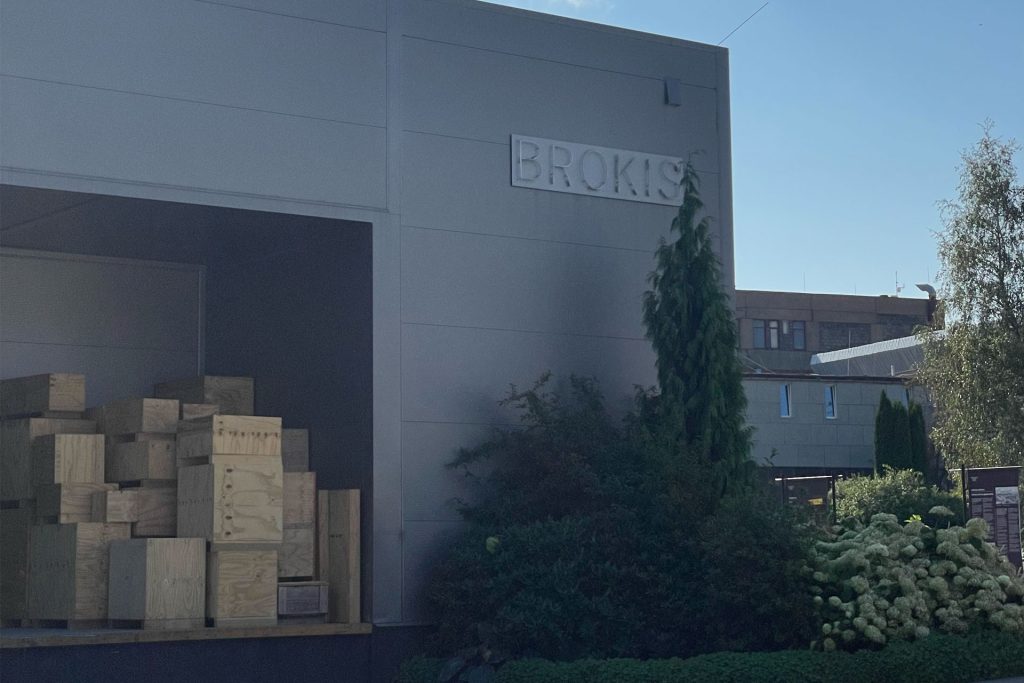
As we entered the expansive newer factory building, the sun’s warmth was soon replaced by the unforgiving heat emanating from the ovens and furnaces. The men and women working there were clearly masters of this craft, each one possessing a blend of confidence and patience to handle molten glass in a way that is so casual and effortless. Watching them manoeuvre metal poles topped with glowing liquid glass was both awe-inspiring and, in all honesty, a bit nerve-wracking too. It was hard not to feel on edge about being in the glassblower’s way, yet equally difficult to resist the urge to get closer and marvel at the fiery dance at the end of their flutes.
The glassblowers worked at their assigned stations where they carried out their part of the production line. We watched the first step where silica is mixed with sand to create colourful glass, which in Brokis’ repertoire are typically translucent, white, smoke brown, rose pink, and orange. When removed from the furnace, the glassblower then continuously spins the molten glass and uses a wooden cup and water to create a smooth surface before gently blowing and turning the hollow pole.
In Rabell’s quest to reinvoke tradition, Brokis avoid using any modern technology, robots, or machines to create their glass parts. However, his vision was to invigorate the industry, which required a more contemporary design. This is when he introduced Lucie Koldova as Designer and Creative Director at Brokis, who’s modern designs brought Brokis to the attention of international interior designers and design enthusiasts.
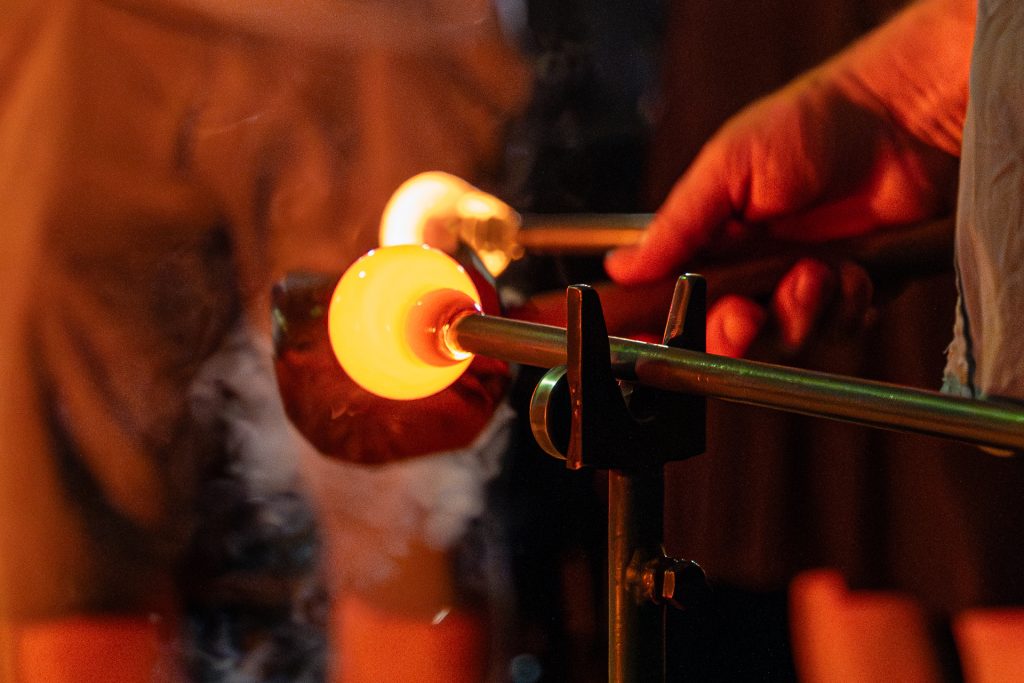
Koldova’s designs often makes unique and graphic shapes that have brought the brand’s glassblowing to whole new level to its predecessors. In one stage of our tour, we watched the creation of one of Koldova’s latest novelties, Spectra, which has an intricate shape that can only be done by one glassblower in the factory. The craftsman makes the piece in one go, blowing the molten glass to size, he then lowers it into a mould located in a pit below floor level of the factory where he continues to blow while a second person helps finalise the shape with compressed air and water. Once the desired shape is achieved, the final piece is put into a kiln to cool very slowly and set. Following the kilning process, items are polished, and quality control checked on a production line before moving to assembly and packaging.
Despite the ease in which the factory workers operate, there are many things that go wrong during the process, which was echoed in the small mountains of shattered glass that were situated outside the factory. However, Rabell showed us that not all is lost when mistakes happen. The team use the broken glass remnants to create furniture pieces such as tabletops, home accessories, or signage. The scraps are melted into sheets of fused, colourful glass that is then cut, washed, and polished into its final shape. This is what is known as Brokisglass.
Following our time on the factory floor, Koldova took over the tour to explain more about the design process. She has been with Brokis since 2013 and is the designer of two of the latest novelties launched this year: the Starcloud and the Spectra. Brokis avoid over saturating the market with seasonal designs and opt for the release of one collection per year with some extensions of best-selling collections, hence the annual celebration of the Glassmakers event. There are many reasons for this including sustainable production, giving each product or product extension the time and attention they need to be appreciated across an international market, and to respect the time that goes into making a Brokis light.
“We need to give space to the collections to make sure that each one gets the right space to penetrate the new markets,” explains Koldova. “Also, the lights must be prepared for all types of market because each is different. For example, the use of different cables and electrical certifications, and so forth can be hard to decipher. So, developing one collection takes a lot time and testing to get it to the right standard for all the markets, which costs a lot of money and effort. Therefore, perfecting one collection per year allows us to be ready for anything.”
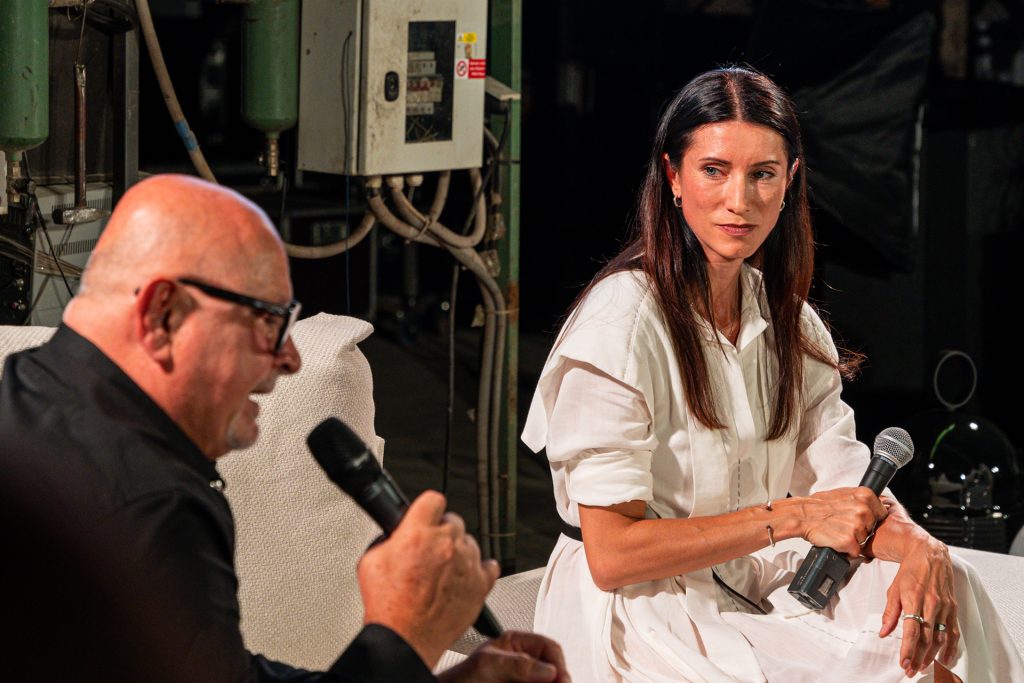
The tour then moved to a small press conference where Italian interior stylist Simona Sbordone and photographer Max Zambelli joined the group to discuss the recently launched Brokis Storyline catalogue. Featuring more than 120 lights from across the Brokis portfolio set in four extraordinary locations, the project marks the beginning of a new chapter in the presentation of the Brokis brand. The catalogue tells the story of a selection of magnificent homes and how the lights change and take on different identities depending on the time of day, all presented in a beautiful large-format printed publication.
In the evening, we returned to the factory for a glamorous night of cocktails, DJ set with a live saxophonist plus, the glassblowers performing their magic skills with opportunities to have dabble with glassblowing ourselves.
Later in the evening, all guests moved into the old factory house, which had been transformed into a showroom displaying new collections from Dome by LCM Marin design studio and Convex by designer Boris Klimek, and novelties from Lucie Koldova taking centre stage. During the unveiling, Koldova spoke about the detail and inspiration of each design. Speaking on her pendant collection ‘Starcloud’, she says: “From the offset, my aim was to design a collection that would let the user create grand constellations. There are three distinct shapes, which I named after three well-known stars: Atria, Lyra, and Vega. The rotational shapes gain in strength and then diminish again, waxing and waning like real stars and completing one another, yet at the same time they exist on their own. They form a shining cloud in the sky, with gentle gradient colours and fluid lines softening the intensity of these cosmically inspired objects.”
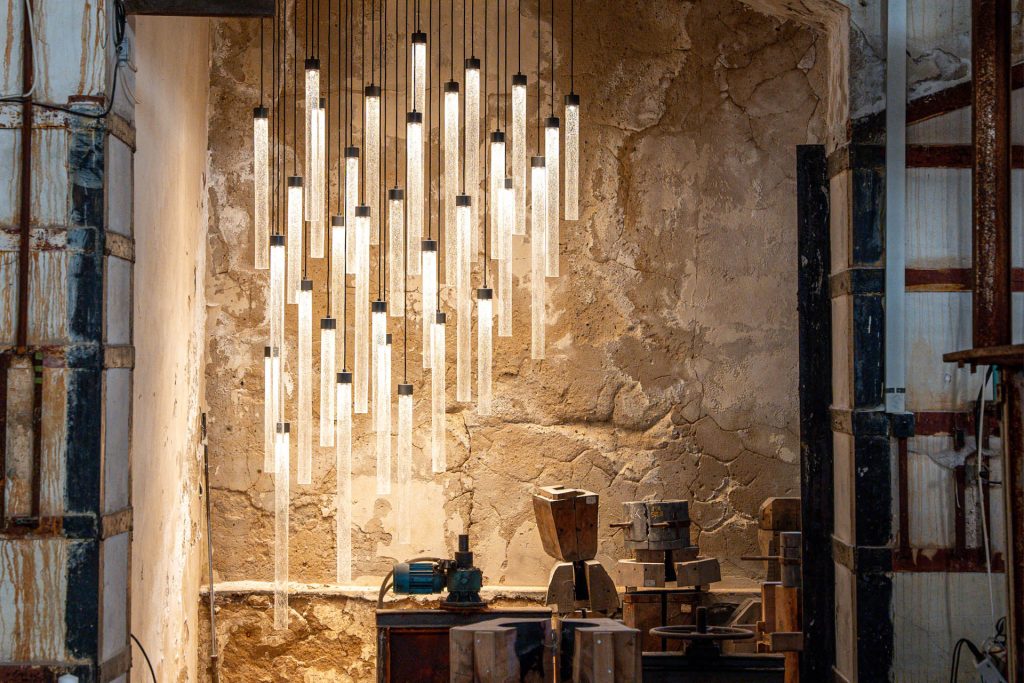
Her second piece, Spectra, (which we saw being made during the tour) is the result of her search to reinvent the archetypal lamp shape but keeping the classic silhouette of a lamp shade and base yet made from one pure piece of glass. Koldova explains: “I wanted to create an elementary, simple line, an external mantle that would serve as the base and the shade in one. The inverted outline of the mantle gives way to an opening in the centre, where I then positioned a two-way light source, the intensity of which can be easily adjusted. The shape of the mantle evokes a sense of levity and loftiness. A specialised method of glassblowing is required to create the mantle as a single piece. The overall appearance of the light emphasises the idea that beauty lies in simplicity.”
After the designers presented their pieces, there was a final unveiling from Rabell and Sbordone, her first collaboration with the brand, a concept piece titled ‘Comet’. The installation displayed an arrangement of approximately 30 tube-like pendants characterised by a distinctive textured glass suspended from different heights, which was created through a special technology of adding silica sand to the molten glass as the glass tubes are hand blown. Comet is another bold statement to the Brokis collection. In addition to the concept chandelier, Sbordine has created a range of home accessories using Brokisglass that were displayed beautifully on pedestals. This set the stage for Rabell’s final announcement of welcoming Sbordine as the new Creative Director of Brokisglass.
As the night drew to a close, we were gifted with a Brokisglass handblown espresso set, all made from the recycled shards of glass. On reflection, the Glassmaker’s Night is about more than celebrating the products and the designers but also a celebration of the glassmakers themselves. Rabell’s aim to revitalise the Czech glassblowing industry has also brought life into the community with many of the locals working for Brokis, acquiring a unique talent that few and far between can do around the world.
LiGHT 24 Welcomes All Designers
(UK) – The only trade show in the UK dedicated to lighting specification provides an incredible opportunity for designers to discover new technologies, solutions and inspiration.
Lighting is one of the first things that designers should consider when working on a project. The importance of working with the right tools and having the right knowledge to produce the best light – and in turn the best environment for the end user – is undeniable.
A common misconception is that trade shows dedicated to lighting specification are just for lighting specialists. Yet by bringing together architects, interior designers and lighting designers with innovative brands and suppliers, LiGHT 24 is the perfect opportunity to find the right lighting for your next project, whatever the role you play.
So, if you’re not a lighting designer, what does LiGHT 24 have to offer you?
If you are looking for ways to more seamlessly integrate the right lighting solutions into your project designs, you can learn more about the effects of lighting on design schemes and the end user. LiGHT 24 will feature 100s of high-end decorative and architectural lighting brands all under one roof. With brands from all over the world on show, it is guaranteed that there will be a product at LiGHT 24 that fits the brief for your next project.
A dedicated space for decorative and design-led lighting brands returns to the gallery level for a second year, focused on providing a space to collaborate, inspire and specify decorative, design-led lighting solutions all under one roof.
This year, the Associations Lounge will host a number of industry associations from the architecture, interior design, and lighting communities, providing a comfortable space for designers to meet with colleagues and gain vital information on the advantages of memberships with these associations.
Not only that, but the next [d]arc thoughts talks programme is taking place at LiGHT 24. This highly-regarded talks programme will feature experts from across the world of design and editors from speciality design magazines, while covering project highlights and topics that affect all areas of the industry. Watch this space for a full talks programme announcement coming very soon!
Are you ready to meet like-minded individuals and make connections in the lighting, interior design and architecture communities? LiGHT 24 offers visitors multiple unrivalled networking opportunities, including late-night welcome drinks during the first evening and the popular LiGHT LUNCH on day two of the event. This year, LiGHT LUNCH will be centred around a Women in Industry networking event - this brunch with representatives from Women in Lighting, Women Lighting Professionals, Women in Office Design, Women in Architecture, and the Women in Furniture Design Network, offers an in-person insightful opportunity to find out more about these empowering initiatives and how to get involved.
Another networking opportunity will be the Silhouette Awards event, which involves the entire global lighting community, featuring advice from the programme's mentors and mentees, education insights, presentations, discussions, and all-important photo opportunities.
LiGHT WORK will also make a welcome return to the show, with visitors making good use of the dedicated workspace area to network, hold meetings, or complete office tasks, while offering dedicated wi-fi, free coffee, and charging points so that you don’t need to leave the show floor to do vital work.
LiGHT Expo values bringing together inspiring leaders and passionate people to share ideas and solutions to grow the future of the industry. For all visitor information, visit: www.lightexpo.london
Don’t miss your chance to be part of this inspiring and influential event! Registration is now OPEN > LiGHT 2024
Original BTC - Christie Light
(UK) – The British lighting manufacturer is releasing a wall light version of its popular Christie light.
The new addition is hand slip-cast at the company’s Stoke-on-Trent factory, with a gently fluted shade that celebrates bone china’s versatility. Featuring the brand’s signature mix of materials, the 47cm shade is secured by solid brass fittings in an antique brass finish.
Charles Bowles, Original BTC Director, says: “From the rise and fall of ocean waves to the corrugation of washed-out shells, each ceramic fold echoes the movement and flow found in nature,” describes the brand. “Crisp white when off, when switched on, Christie emits a beautifully ambient glow, casting light through the shade and hypnotic shadow onto the wall behind. One of our most decorative, large scale wall lights yet, Christie will soften the clean lines of contemporary spaces while blending beautifully with more traditional schemes.”
Moooi opens showroom in LA
(USA) – Lifestyle brand Moooi has announced its latest showroom in Culver City, Los Angeles is now open.
Designed by Amsterdam-based studio, BeyondSpace, the showroom’s interior displays a minimalist space, inspired by the work of artist Richard Serra while also partnering with Senso, a sustainable Dutch flooring company, together creating one-of-kind space. The curved layout of the room evokes the feeling of curiosity and is curated to complement Moooi’s pieces.
The showroom is available to visit by appointment only to provide a personalised experience for clients, while visitors can engage in talks, styling sessions, and exclusive events. Local Moooi dealers can also use the space as an extension of their own showrooms, offering to showcase the latest and greatest from Moooi’s collection.
Joshua Muenzenmayer, Moooi’s Head of Americas, says: “Los Angeles is one of the cultural and economic capitals of the world – filled with creators, innovators, and trendsetters. I couldn't think of a better community to bring Moooi's creative and luxurious collection to, alongside Senso, who shares our same commitment to quality and innovation."
Catellani & Smith - Bellatrix
(Italy) – Catellani & Smith introduces Bellatrix, a new wall lamp inspired by the Orion constellation.
The lamp is handcrafted into an irregular disk shape with a 120cm diameter and hand-painted in gold-coloured leaf. Available in two different patterns, which include one with a movement of hand-drawn radial lines and a second on which a swirling pattern is visible.
The disc is lit with nine LED boards built into a brass rod with a diameter of 10mm and is supported by a flexible brass arm to adjust the light as desired. The interplay of Light with an irregular gilded surface, together with the indirect light affect, is signature to Catellani & Smith.
Quasar - Pixel Sphere
(Netherlands) – Quasar welcomes a new addition to the Jam Pauwels collection with Pixel Sphere ceiling light.
Pixel Sphere is a twist on the standard Cosmos Square within the collection. Through its ‘stepped layers’ from a distance, the fixture is spherical in appearance but made up of 12.5sqcm and comprised of metal rods and LEDs. Its size is 170cm x 170cm x 203cm, however, it can be customised to any requirements.
Original BTC - Crosby
(UK)- England-based luxury lighting brand Original BTC launches its first glass-based table lamp marking the opening of its Oxfordshire glassworks.
The manufacturer moved its glass-making operation from Birmingham to Oxfordshire in 2023 in a strategic move to improve environmental impact while retaining staff and centuries-old glassblowing traditions, which are showcased in Crosby’s design.
Charlie Bowels, Director of Original BTC, says: “Our commitment to British manufacturing has remained steadfast since our launch in 1990. As a family-run business, we want to take responsibility for our impact on the world around us. Local production, timeless design, quality materials and the finest craftsmanship have always been the cornerstones of Original BTC.”
He adds: “In 2011, we purchased English Antique Glass, the country’s only remaining manufacturer of flat glass, to craft glass shades as well as continue flat glass production. When asked to leave the original factory as the site was being re-developed, we chose to relocate to our Witney headquarters, investing heavily in the creation of a new space that would reduce component and travelling miles between our manufacturing and assembly facilities, as well as reducing our need for packaging – a great stride forward in our sustainability journey.”
Crosby’s design features a glossy anthracite cylinder fitted with a solid brass base, sandblasted to create a textured finish with a neatly curved opening for the cable. Available in three sizes and topped with a linen shade and cotton cable.
Meet the New Designers: George Almond
In a special three-part Q&A series on the New Designers awards programme, darc magazine has spotlighted standout designers recognised for their contributions to decorative lighting product design.
New Designers is an annual exhibition that brings together graduate design talent from across the UK, which made its return to the BDC in London for its 39th year. The event featured the work of 3,000 graduates from over 100 universities.
For those of you who missed it, check out the first two designer interviews darc held with Oscar Parkinson and Holly Munro to discover more about their experiences of the event and their lighting creations.
For our third and final Q&A, darc talks to Habitat award winner George Almond. Almond is an undergraduate from Nottingham Trent University where he studies Product and Furniture Design. His design won the Habitat New Designer award for his Dondo rocking stool and Lever floor lamp, which has gained him a mentoring programme from Habitat's design studio.
Can you share a bit about your background and what led you to pursue a career in design?
My background in design most likely stemmed from my family. We are all quite practical people and enjoy creating things. My parents built our house, so I grew up on a construction site; often playing around with offcuts and scrap material. I enjoy making things with my hands and so this led me down the road of designing and making. Over the COVID-19 pandemic lockdown, with the help of my dad, I built a small workshop in our garage so that I could do various woodwork projects in the ample free time I had. I liked learning new techniques and developing my practical skills.
What significance does winning the New Designer Award hold for you, and how will it impact your career?
Winning the Habitat New Designer Award has been a massive achievement for me. Being able to go and present my work was a fantastic opportunity in itself, but winning an award has allowed me to have more conversations and connections across the design industry than I ever thought I could. This award will be a great head start in my career in design and allow me to achieve my goals in the industry.
What inspired you to create a lighting collection specifically?
This project was an experimentation of materials and processes. The forms I was playing with and creating led perfectly into a light shade for an adjustable floor light. The process dictated the sizes and shape of the shade, making it most suitable for a larger floor lamp rather than a pendant or desk lighting.
Could you elaborate on the inspiration and creative process behind your award-winning design?
I find inspiration in mastering new skills and exploring innovative processes, driving me to push materials to their limits and forge innovative design solutions. This project was conceived with the aim of harnessing steam-bending as a process-driven design approach, leveraging the inherent properties of the material to their fullest extent. By capitalising on the natural tension generated during the bending of wood, I crafted a joint devoid of screws or glue, achieving both structural integrity and aesthetic elegance. The lamp's adjustability is facilitated through a clamp-like mechanism, strategically designed to utilise opposing forces, creating a lever that prevents the arm from sliding when angled.
With my work, I aim to provide new solutions to problems with an appropriate use of materials and consideration for manufacturing processes. I don’t want to design more of what is already available, it has to be unique and intriguing for the user.
Which environment is your product best suited to, and why? For example, the hospitality market, residential, somewhere else?
The functionality of the floor lamp leans itself to the residential environment due to its adjustability for different uses. At its maximum height, the lamp casts a gentle ambient glow, perfect for creating an inviting room atmosphere. Lowering the shade directs light into a focused area, ideal for illuminating workspaces or study areas. The versatility of the Lever Floor Lamp ensures its adaptability to various settings and applications throughout the home.
Does sustainability and responsible design influence your design choices and processes?
My main focus for sustainability with this project was to use materials as effectively as possible, reducing waste and unnecessary material usage. Through steam bending I was able to use a single piece of wood to form the shade, joint, and movement mechanism, reducing the need for additional materials and machine processes. Product end-of-life is also important, which is why each component of my light can be separated into single materials for recycling or reuse.
Do you see yourself continuing in the field of lighting design, or do you have other areas of interest you'd like to explore in the future?
Having studied Furniture and Product design, I don’t want to limit myself to a single niche aspect of the design industry. As much as I enjoy lighting, I would also like to continue in the field of furniture. Interaction with good design is something I enjoy, whether that be lighting or something else like seating, so in the future I will continue to put user engagement at the centre of my designs.
What are your aspirations for the next five years?
Currently, I don’t have a specific path I want to follow. I enjoy the practical side of design, being in the workshop making prototypes and experimenting with physical models. I would like to see myself working in a role that would allow me to continue my passion for designing through making. I know that I still have a lot to learn, so aspire to continue expanding my knowledge and developing my skills as a designer.
www.instagram.com/george.almond_design
Luxxbox partners with Panzeri
(International) - The international designer of acoustic lighting Luxxbox announced its partnership with renowned Italian lighting brand, Panzeri.
The strategic merger presents Luxxbox the opportunity for continued growth and to enter new European markets where sound absorption in commercial environments has become increasingly important for designers. For Panzeri, the partnership will expand its US presence, aligning two companies dedicated to creating lighting fixtures that enhance the well-being of spaces.
Panzeri and Luxxbox share a strong commitment to corporate culture, authentic design, and product quality, making the benefits of their partnership evident from the start. Both companies design and manufacture products in-house focusing their attention to details to create unique market offerings. This also allows both companies to uphold eco-sustainable productivity by adopting innovative equipment, technology, and design practices.
Jason Bird, Founder and Creative Director of Luxxbox, says; “This is a great opportunity for Luxxbox’s ongoing growth, and I’m excited to embark on this journey with Panzeri. There is a genuine understanding of our shared values and how we can work together to benefit each other, and most importantly, our customers.”
Industville releases its range with John Lewis
UK) - Sustainable hand-crafted lighting and décor company has launched a range of products with British retailer John Lewis.
Its partnership signals an expansion in Industville’s retail presence.
Launched on 26 June, the selection of 27 products and designs are now available on the John Lewis website. The edit includes decorative and function pieces including wall fixtures, pendants and table lamps.
Mara Rypacek, Founder of Industville, says; “We are incredibly proud to partner with John Lewis. Their reputation for excellence and commitment to quality aligns perfectly with or core values and together we look forward to illuminating homes across the nation with our design-led, handcrafted lighting. The collaboration is already off to an exciting start with orders rolling in and we’re excited to see what the future holds.”
Meet the New Designers: Oscar Parkinson

New Designers is an annual exhibition that brings together graduate design talent from across the UK, which made its return to the BDC in London for its 39th year. The event featured the work of 3,000 graduates from over 100 universities.
Continuing our Q&A series covering emerging decorative lighting designs from the event, darc speaks with the Made.com Stand Out winner Oscar Parkinson who made waves with his Riso printed paper lights.
To read our first Q&A in the series with designer Holly Munro and to find out more about the New Designers awards, click here.
Can you share a bit about your background and what led you to pursue a career in design?
I just finished up my BA in product and furniture design at Kingston School of Art (KSA), before which I did an art foundation (also at KSA). In my foundation year I studied visual communication, which led me to start a graphic design course. I learnt a lot from these two years, but when I was extruding letterforms to try and make benches, I started to reconsider which course was right for me. So, I switched over to product and furniture design, which was a much better fit for me. I’m definitely most suited to the world of 3D design.
What significance does winning the New Designer Award hold for you, and how will it impact your career?
Winning an award from Made.com at New Designers awards was a big surprise for me and it was nice to have a series of paper lights recognised by such a large brand that is probably best known for its furniture. It has given me a lot of confidence in my ability and the kind words from the MADE team about the project have definitely made me want to take the project forward and formalise it into a fully formed product.
What inspired you to create a lighting collection specifically?
I’ve found myself designing lighting quite a lot over the duration of my course. I particularly love how it can transform the atmosphere of a space in a way that other designed objects often cannot. I also love how light can bring out properties of materials that are hidden under normal circumstances, something which the Riso series explores in particular with paper and print.
Could you elaborate on the inspiration and creative process behind your award-winning design?
The Riso collection is a series of six paper lights that celebrate the process of risograph printing. A quick and affordable form of ‘digital screen printing’, the riso machine prints colours one at a time in layers that can be built up to form new tones. The paper shades are all printed on the inside, protecting the delicate prints from smudging, as the soy-based ink never fully dries, which leads to an element of surprise when the light turns on and the print is revealed. Lots of the design was informed by the restrictions of the riso machine such as the paper weight, which is the heaviest the riso machine can print on; and size, as all elements have to be able to fit on either A3 or A4. The patterns themselves are informed by either the way the light falls on the paper (in a gradient), paper archetypes (the grid), or the mixing of ink layers (overlapping strokes).
Which environment is your product best suited to, and why? For example, the hospitality market, residential, somewhere else?
I think the Riso lights are best suited to the domestic environment as they create a cosy atmosphere with the orange and pink from the prints creating a warm light. Although I wouldn’t want to limit their application if someone saw potential in them that I haven’t.
Does sustainability and responsible design influence your design choices and processes?
With the ink being soy-based, that sustainable aspect of risograph printing was a big draw for me to start testing for the Riso lights. I wanted to build on that, with every element of each design being able to be replaced if damaged. I could have glued the paper shade to the bases for example but decided to keep them separate to hopefully encourage users to simply replace the shade rather than throw away the whole thing if it became damaged.
Do you see yourself continuing in the field of lighting design, or do you have other areas of interest you would like to explore in the future?
I would love to keep designing lights and have a couple of ideas in the pipeline alongside developing the Riso lights. I would love to do something on a larger scale to see how that could affect a space differently to the smaller scale I’ve been working on so far. A site-specific project where I can try and create an atmosphere for a particular crowd or activity would be really fun. I do love designing beyond lighting as well though and want to keep the space to design products and furniture in all its forms.
What are your aspirations for the next five years?
I’m just going to see where the next five years take me, I don’t have a specific plan to follow. I want to get as much experience as possible in a wide variety of working environments and see what clicks with me as a way of working and thinking. I would love to keep my own projects going alongside working for other people, so hopefully I can find the space and time for that. I still believe it’s really valuable to learn what you don’t want to do as well as what you do, and I just want to keep a sense of design community and surround myself with people who are up for a good chat about design.


